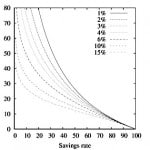This past year was the first year in some time that I had maxed out contributions to my 401(k).
We’ve been in our new house for a few years now, and have been able to replenish our emergency fund to about 8-10 months of expenses.
After all that was taken care of I knew it was time to start maxing out the contributions to the 401(k) again.
In 2019 we plan on once again investing as much as we can in our Roth IRA first over at WiseBanyan, and then also maxing out the contributions to the company sponsored 401(k).
The Roth IRA has seen a few minor changes for 2019, including boosting the contribution limit to $6,000.
Today I thought I would take an in depth look at what the 401k contribution limits, rules and regulations will be for 2019 as well, since we plan on maxing them both out.

The IRS released their 401k contribution guidelines this past week, and the max contribution has increased for 2019! That means you’ll be able to contribute more in 2019 than in 2018!
The contribution limit for employees who participate in 401(k), 403(b), most 457 plans, and the federal government’s Thrift Savings Plan is increased from $18,500 to $19,000.
Quick Navigation
401(k) – Origins Of The Tax Deferred Savings Plan
So where did the 401(k) originate, and where does it get it’s name?
The 401(k) gets it’s name from the subsection of the IRS code where the rules and regulations for the retirement account are laid out and provisioned. Exciting, right?
The 401(k) first became law in 1978, and was widely adopted in the 1980s as a cheaper alternative to traditional pension plans, which were usually paid for by employers. It began a shift away from the responsibility of saving for retirement from the employer, to the employee.
When you are saving in a 401(k) there are a bunch of rules and regulations you’ll need to know about, including rules about how much you (and your employer) can contribute, when you can withdraw the money and under what circumstances. So let’s jump in and take a look.
Contribution Limits For The 401(k) In 2019
The 401(k) contribution limits are a set limit beyond which you can’t contribute to your account. It’s the maximum you can contribute under this tax deferred plan – although you can also contribute to a Roth IRA, or to a taxable investment.
There was a small increase in the consumer price index this year, and the contribution limits will go up $500. That means the contribution limit goes from $18,500 to $19,000. The following table will show the maximum yearly contribution for the 401k account type every year since 2007.
| Year | 401k Contribution Limit |
|---|---|
| 2007 | $15,500 |
| 2008 | $15,500 |
| 2009 | $16,500 |
| 2010 | $16,500 |
| 2011 | $16,500 |
| 2012 | $17,000 |
| 2013 | $17,500 |
| 2014 | $17,500 |
| 2015 | $18,000 |
| 2016 | $18,000 |
| 2017 | $18,000 |
| 2018 | $18,500 |
| 2019 | $19,000 |
| 2020 | $19,500 |
| 2021 | $19,500 |
| 2022 | $20,500 |
| 2023 | $22,500 |
| 2024 | $23,000 |
Since 2007 we have seen an increase of $3500 in the 401(k) contribution limits.
Employer Contribution Limits For 401(k) For 2019
Employers are able to contribute to an employee’s 401(k) plan as well. If your employer offers to contribute, take them up on that offer. It’s free money!
Employers often will contribute a percentage match, of your contribution up until a certain percentage of your income. For example, they may match 50% of your contributions, up to 6% of your salary.
Certain employers will also cap how much you can contribute to the company’s 401k plan. If you are a highly compensated employee (HCE), making above $125,000 in 2019, you might be subject to additional limits in your company’s 401(k). The rules get a bit complicated, and the rules are essentially there in order to encourage more 401(k) plan participation by less highly paid employees, but because of them often a company will not allow HCE to contribute more than a certain percentage of their income.
Just make sure to check with your 401(k) plan administrator to find out what your plan’s limitations are. They may be different from the government limits.
401(k) Catch-Up Contribution Limits For 2019
If you are at or over the age of 50 by the end of the 2019 tax year, and your plan allows it, you can make a catch up contribution to your 401(k) plan.
| Year | 401k Catch-Up Contribution Limit |
|---|---|
| 2007 | $5000 |
| 2008 | $5000 |
| 2009 | $5500 |
| 2010 | $5500 |
| 2011 | $5500 |
| 2012 | $5500 |
| 2013 | $5500 |
| 2014 | $5500 |
| 2015 | $6000 |
| 2016 | $6000 |
| 2017 | $6000 |
| 2018 | $6000 |
| 2019 | $6000 |
| 2020 | $6500 |
| 2021 | $6500 |
| 2022 | $6500 |
| 2023 | $7500 |
| 2024 | $7500 |
The catch up contribution limits have remained the same this year at $6000.
Do Employer Contributions Affect Your Limit?
One source of some confusion for people is whether their employer’s contributions to their 401(k) will affect their own contribution limits. In other words, will their limit of $19,000 be affected by their employer’s contribution to their account.
In short, it won’t affect the employee’s limit.
The limits for employer and employee contributions are separate, and don’t affect each other. That’s good news because it means you can contribute more if your employer is making contributions for you!
Example: If someone makes $100,000 in pre-tax compensation, and their employer will contribute 50% of the first 6% , they could have $19,000 contributed by the employee, and $3,000 by the employer for a total of $22,000. If they’re over 50 they could also make catch up contributions for a total of $28,000.
Maximum Contribution For 2019
One more thing to consider when looking at 401(k) plans for 2019.
The maximum contribution to a 401(k) plan when taking into account employee contributions, employer matching and other contributions is $56,000 or 100% of their compensation, whichever is less. That is a $1,000 increase from 2018.
Hopefully I’ll be in a position some day to be putting in and receiving that kind of a contribution!
Do you contribute to a 401(k)? Do you expect to reach the max contribution next year?




Share Your Thoughts: